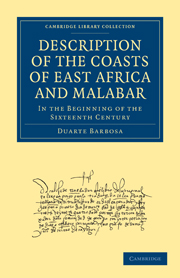DESCRIPTION OF THE EAST INDIES AND COUNTRIES ON THE SEABORD OF THE INDIAN OCEAN IN 1514
Published online by Cambridge University Press: 07 September 2010
Summary
THE CAPE OF ST. SEBASTIAN AFTER PASSING THE CAPE OF GOOD HOPE
Having passed the Cape of Good Hope in a north-easterly direction, at Cape San Sebastian, there are very fair mountain lands, and fields, and valleys, in which there are many cows and sheep, and other wild animals; it is a country inhabited by people who are black and naked. They only wear skins with the fur of deer, or other wild animals, like some cloaks in the French fashion, of which people the Portuguese, up to the present time, have not been able to obtain information, nor to become acquainted with what there is in the interior of the country. They have no navigation, neither do they make use of the sea, neither have the Moors of Arabia and Persia, or the Indies, ever navigated as far as this, nor discovered them, on account of the strong currents of the sea, which is very stormy.
ISLANDS OF THE GREAT UCIQUES
Having passed Cape San Sebastian towards the northeast for India, there are some islands close to the mainland to the east, which are called the Great Uciques; in which, on the side towards the mainland there are a few small towns of Moors, who deal with the people of the continent, and they provision themselves from them.
- Type
- Chapter
- Information
- Description of the Coasts of East Africa and MalabarIn the Beginning of the Sixteenth Century, pp. 3 - 229Publisher: Cambridge University PressPrint publication year: 2010First published in: 1866



